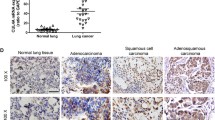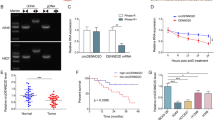Abstract
CC chemokine receptor-9 (CCR9) is highly expressed in non-small cell lung cancer (NSCLC) tissues and cell lines. However, the biological functions and the signals elicited by the interaction between CCR9 and its natural ligand CCL25 in NSCLC are unknown. Here, we selectively depleted CCR9 and inhibited CCR9–CCL25 interaction in NSCLC cells using small recombinant lentivirus-mediated miRNA, and investigated the tumorigenic effects in vitro and in vivo. Compromised CCR9–CCL25 interaction promoted apoptosis in NSCLC cells by activating phosphoinositide 3-kinase (PI3K)/Akt in vitro. In addition, we showed that CCR9–CCL25 interaction mediated the activation of the PI3K/Akt pathway in NSCLC cells, resulting in the up-regulation of anti-apoptotic proteins, as well as the down-regulation of apoptotic proteins in a PI3K-/Akt-dependent manner. These CCR9–CCL25-mediated effects were abrogated in the presence of a PI3K inhibitor (wortmannin 10 nM) or by inhibiting the CCR9–CCL25 interaction through CCR9 silencing, which also suggested that the biological function of CCR9–CCL25 was mainly regulated by PI3K. In vivo studies also demonstrated a significantly lower tumor burden in mice receiving CCR9-silence cells than those in mice receiving control cells. Together, these data suggested that CCR9–CCL25 interaction induced tumorigenesis of NSCLC cells and that this induction might be accomplished through the activation of the PI3K/Akt pathway. These findings may lead to a better understanding of the biological effects of CCR9–CCL25 interaction and provide clues for identifying novel therapeutic and preventive molecular markers for NSCLC.




Similar content being viewed by others
Abbreviations
- CCR9:
-
CC chemokine receptor-9
- NSCLC:
-
Non-small cell lung cancer
- PI3K:
-
Phosphoinositide 3-kinase
- GPCRs:
-
G protein-coupled receptors
- TECK:
-
Thymus-expressed chemokine
- SCCs:
-
Squamous cell carcinomas
- ACs:
-
Adenocarcinomas
- GFP:
-
Green fluorescent protein
References
Siegel R, Ma J, Zou Z, Jemal A. Cancer statistics, 2014. CA. 2014;64(1):9–29.
Kathuria H, Gesthalter Y, Spira A, Brody JS, Steiling K. Updates and controversies in the rapidly evolving field of lung cancer screening, early detection, and chemoprevention. Cancers. 2014;6(2):1157–79.
Cheng H, Shcherba M, Pendurti G, Liang Y, Piperdi B, Perez-Soler R. Targeting the PI3K/AKT/mTOR pathway: potential for lung cancer treatment. Lung Cancer Manag. 2014;3(1):67–75.
Ko JC, Chiu HC, Syu JJ, Chen CY, Jian YT, Huang YJ, Wo TY, Jian YJ, Chang PY, Wang TJ, et al. Down-regulation of MSH2 expression by Hsp90 inhibition enhances cytotoxicity affected by tamoxifen in human lung cancer cells. Biochemical and biophysical research communications. 2015;456(1):506–12.
Fumarola C, Bonelli MA, Petronini PG, Alfieri RR. Targeting PI3K/AKT/mTOR pathway in non small cell lung cancer. Biochem Pharmacol. 2014;90(3):197–207.
Rostene W. New prospects for chemokines. Biologie aujourd’hui. 2010;204(4):267–72.
Uehara S, Hayes SM, Li L, El-Khoury D, Canelles M, Fowlkes BJ, Love PE. Premature expression of chemokine receptor CCR9 impairs T cell development. J Immunol. 2006;176(1):75–84.
Heinrich EL, Arrington AK, Ko ME, Luu C, Lee W, Lu J, Kim J. Paracrine activation of chemokine receptor CCR9 enhances the invasiveness of pancreatic cancer cells. Cancer Microenviron. 2013;6(3):241–5.
Johnson EL, Singh R, Johnson-Holiday CM, Grizzle WE, Partridge EE, Lillard JW Jr, Singh S. CCR9 interactions support ovarian cancer cell survival and resistance to cisplatin-induced apoptosis in a PI3K-dependent and FAK-independent fashion. J Ovarian Res. 2010;3:15.
Johnson-Holiday C, Singh R, Johnson EL, Grizzle WE, Lillard JW Jr, Singh S. CCR9–CCL25 interactions promote cisplatin resistance in breast cancer cell through Akt activation in a PI3K-dependent and FAK-independent fashion. World J Surg Oncol. 2011;9:46.
Sharma PK, Singh R, Novakovic KR, Eaton JW, Grizzle WE, Singh S. CCR9 mediates PI3K/AKT-dependent antiapoptotic signals in prostate cancer cells and inhibition of CCR9–CCL25 interaction enhances the cytotoxic effects of etoposide. Int J Cancer J. 2010;127(9):2020–30.
Zhang Z, Qin C, Wu Y, Su Z, Xian G, Hu B. CCR9 as a prognostic marker and therapeutic target in hepatocellular carcinoma. Oncol Rep. 2014;31(4):1629–36.
Gupta P, Sharma PK, Mir H, Singh R, Singh N, Kloecker GH, Lillard JW Jr, Singh S. CCR9/CCL25 expression in non-small cell lung cancer correlates with aggressive disease and mediates key steps of metastasis. Oncotarget. 2014;5(20):10170–9.
Fan JA, Zhang L, Wang QL, Lin H. Chemokine receptor 9 high-expression involved in the migration and invasion of the non-small-cell lung cancer cells. Asian Biomed. 2011;5(1):69–76.
Czabotar PE, Lessene G, Strasser A, Adams JM. Control of apoptosis by the BCL-2 protein family: implications for physiology and therapy. Nat Rev Mol Cell Biol. 2014;15(1):49–63.
Dufour M, Dormond-Meuwly A, Pythoud C, Demartines N, Dormond O. Reactivation of AKT signaling following treatment of cancer cells with PI3K inhibitors attenuates their antitumor effects. Biochem Biophys Res Commun. 2013;438(1):32–7.
Kuzumaki N, Suzuki A, Narita M, Hosoya T, Nagasawa A, Imai S, Yamamizu K, Morita H, Suzuki T, Okada Y, et al. Multiple analyses of G-protein coupled receptor (GPCR) expression in the development of gefitinib-resistance in transforming non-small-cell lung cancer. PLoS One. 2012;7(10):e44368.
Bhola NE, Thomas SM, Freilino M, Joyce S, Sahu A, Maxwell J, Argiris A, Seethala R, Grandis JR. Targeting GPCR-mediated p70S6 K activity may improve head and neck cancer response to cetuximab. Clin Cancer Res. 2011;17(15):4996–5004.
Crudden C, Ilic M, Suleymanova N, Worrall C, Girnita A, Girnita L. The dichotomy of the insulin-like growth factor 1 receptor: RTK and GPCR: Friend or foe for cancer treatment? Growth Horm IGF Res. 2015;25(1):2–12.
Parra M, Herrera D, Calvo-Calle JM, Stern LJ, Parra-Lopez CA, Butcher E, Franco M, Angel J. Circulating human rotavirus specific CD4 T cells identified with a class II tetramer express the intestinal homing receptors alpha4beta7 and CCR9. Virology. 2014;452–453:191–201.
Zhu Z, Wang R, Ren L, Xu T. Characterization of the CCR3 and CCR9 genes in miiuy croaker and different selection pressures imposed on different domains between mammals and teleosts. Dev Comp Immunol. 2013;41(4):631–43.
Chamorro S, Vela M, Franco-Villanueva A, Carramolino L, Gutierrez J, Gomez L, Lozano M, Salvador B, Garcia-Gallo M, Martinez AC, et al. Antitumor effects of a monoclonal antibody to human CCR9 in leukemia cell xenografts. mAbs. 2014;6(4):1000–12.
Schlitzer A, Heiseke AF, Einwachter H, Reindl W, Schiemann M, Manta CP, See P, Niess JH, Suter T, Ginhoux F, et al. Tissue-specific differentiation of a circulating CCR9- pDC-like common dendritic cell precursor. Blood. 2012;119(25):6063–71.
Youn BS, Kim YJ, Mantel C, Yu KY, Broxmeyer HE. Blocking of c-FLIP(L)—independent cycloheximide-induced apoptosis or Fas-mediated apoptosis by the CC chemokine receptor 9/TECK interaction. Blood. 2001;98(4):925–33.
Peng SF, Lee CY, Hour MJ, Tsai SC, Kuo DH, Chen FA, Shieh PC, Yang JS. Curcumin-loaded nanoparticles enhance apoptotic cell death of U2OS human osteosarcoma cells through the Akt-Bad signaling pathway. Int J Oncol. 2014;44(1):238–46.
Li T, Kilic A, Wei X, Wu C, Schwartzbauer G, Yankey GK, DeFilippi C, Bond M, Wu ZJ, Griffith BP. Regional imbalanced activation of the calcineurin/BAD apoptotic pathway and the PI3K/Akt survival pathway after myocardial infarction. Int J Cardiol. 2013;166(1):158–65.
Song G, Ouyang G, Bao S. The activation of Akt/PKB signaling pathway and cell survival. J Cell Mol Med. 2005;9(1):59–71.
Li H, Zeng J, Shen K. PI3K/AKT/mTOR signaling pathway as a therapeutic target for ovarian cancer. Arch Gynecol Obstet. 2014;290(6):1067–78.
Martini M, De Santis MC, Braccini L, Gulluni F, Hirsch E. PI3K/AKT signaling pathway and cancer: an updated review. Ann Med. 2014;46(6):372–83.
Nilsen J, Chen S, Irwin RW, Iwamoto S, Brinton RD. Estrogen protects neuronal cells from amyloid beta-induced apoptosis via regulation of mitochondrial proteins and function. BMC Neurosci. 2006;7:74.
Peng DJ, Wang J, Zhou JY, Wu GS. Role of the Akt/mTOR survival pathway in cisplatin resistance in ovarian cancer cells. Biochem Biophys Res Commun. 2010;394(3):600–5.
Acknowledgments
This work was supported by the Scientific Research and Technological Development Projects of Guangxi, China (No. 0816004-8). We thank the scientific research experiment center of the People’s Hospital of Guangxi Zhuang Autonomous Region for technical support.
Conflict of interest
The authors have no conflict of interest.
Author information
Authors and Affiliations
Corresponding author
Rights and permissions
About this article
Cite this article
Li, B., Wang, Z., Zhong, Y. et al. CCR9–CCL25 interaction suppresses apoptosis of lung cancer cells by activating the PI3K/Akt pathway. Med Oncol 32, 66 (2015). https://doi.org/10.1007/s12032-015-0531-0
Received:
Accepted:
Published:
DOI: https://doi.org/10.1007/s12032-015-0531-0




